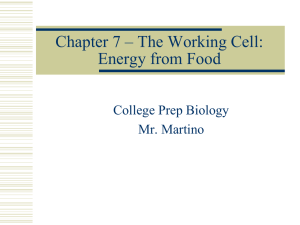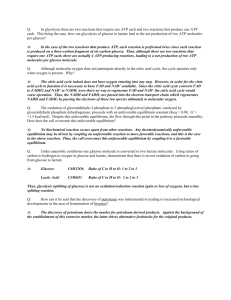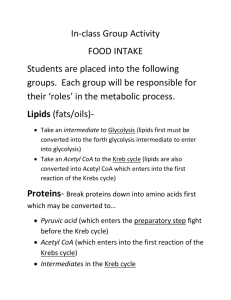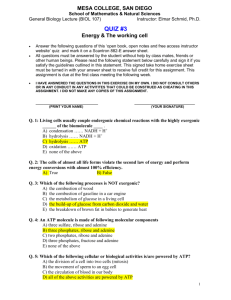RESP
advertisement
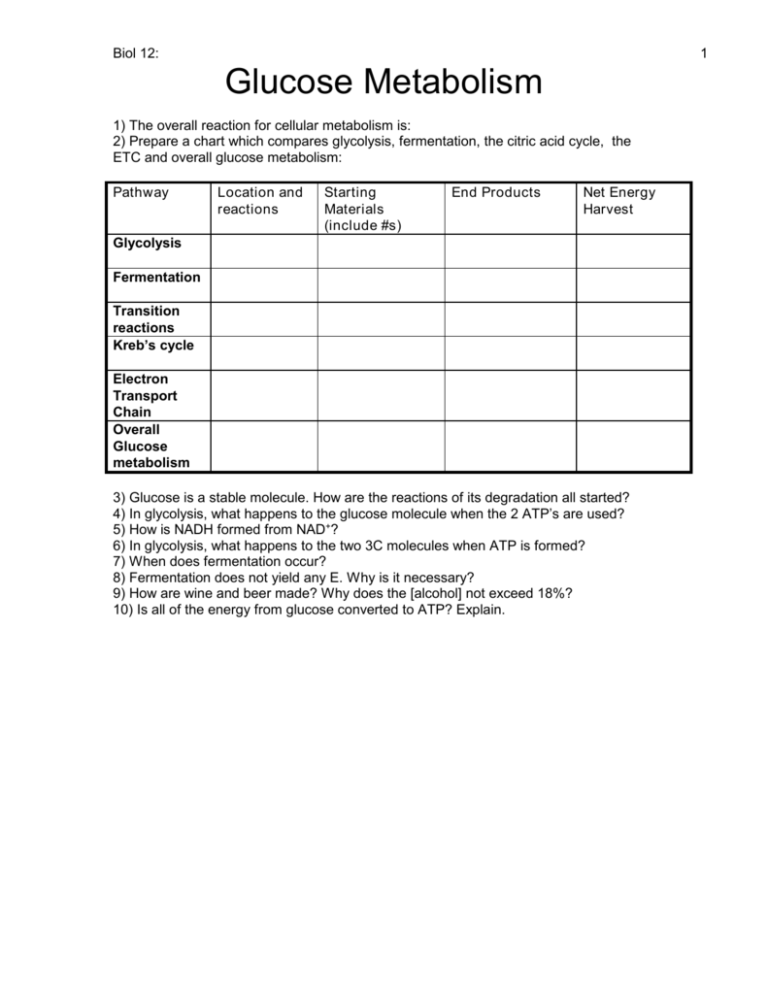
Biol 12: 1 Glucose Metabolism 1) The overall reaction for cellular metabolism is: 2) Prepare a chart which compares glycolysis, fermentation, the citric acid cycle, the ETC and overall glucose metabolism: Pathway Location and reactions Starting Materials (include #s) End Products Net Energy Harvest Glycolysis Fermentation Transition reactions Kreb’s cycle Electron Transport Chain Overall Glucose metabolism 3) Glucose is a stable molecule. How are the reactions of its degradation all started? 4) In glycolysis, what happens to the glucose molecule when the 2 ATP’s are used? 5) How is NADH formed from NAD+? 6) In glycolysis, what happens to the two 3C molecules when ATP is formed? 7) When does fermentation occur? 8) Fermentation does not yield any E. Why is it necessary? 9) How are wine and beer made? Why does the [alcohol] not exceed 18%? 10) Is all of the energy from glucose converted to ATP? Explain. Biol 12: 2 Glucose Metabolism Complete Glucose Metabolism: C6H12O6 + 6 O2 -----> 6 CO2 + 6 H2O + E Occurs in two Stages: Glycolysis & Cellular Respiration -does not require O2 - requires O2 - occurs in the cytosol - occurs in the mitochondria - see figure 8-1, page 142 1. Glycolysis overall reaction: glucose ----------> 2 pyruvic acid + 2 ATP THIS process also occurs in two stages: A. Glucose activation - 2 ATP molecules each donate a phosphate to make FDP (fructose diphosphate) - FDP is highly reactive Biol 12: 3 Glucose Metabolism 2 ATP 2 ADP glucose ------>------>------>--------> FDP B. Energy harvest - FDP splits into 2 PGAL - PGAL go through a series of reactions - the end product is 2 pyruvic acid molecules AND 4 ATP, 2 NADH 4 ADP 4 ATP 2 PGAL ----->----->----->----->2 pyruvic acid 2 NAD+ 2 NADH NET GAIN: 2 ATP and 2 NADH (e carriers) See Page 144 for details on glycolysis FERMENTATION: If O2 is not present, the two molecules of pyruvic acid are used to regenerate the NAD+ so that glycolysis can continue. Biol 12: 4 Glucose Metabolism - this process can occur in two ways: NADH NAD+ i) pyruvic acid ---------------> Lactic Acid - toxic at high [ ] In our bodies, lactic acid is reconverted to pyruvic acid when O2 becomes available - bacteria ferment yogurt, sour cream and cheese this way NADH NAD+ ii) pyruvic acid ---------------------> ethanol + CO2 - also toxic at high [ ] - microorganisms, and most yeast regenerate their NAD+ this way Fermentation occurs when O2 is limited. (anaerobic conditions) However, under aerobic conditions, pyruvic acid is transported across the mitochondrial membrane and enters the second stage of glucose metabolism: 2. Cellular Respiration Biol 12: 5 Glucose Metabolism - requires O2 to be the final electron acceptor Can be broken into 3 Stages: a. Transition Reaction: after being shuttled into the mitochondrial matrix, pyruvic acid is broken down to acetyl CoA and 2 CO2 . (pyruvic acid is oxidized during this process) b. The Kreb’s cycle (citric acid cycle) Acetyl CoA enters a cyclical series of oxidation reactions producing 2 CO2 , 1 ATP, 3 NADH and I FADH2 c. The Electron Transport Chains (respiratory chains) The electron carriers, NADH and FADH2 are shuttled to the inner membrane where they donate their electrons and/or Hydrogens. This ultimately drives the synthesis of ATP via chemiosmosis. Biol 12: 6 Glucose Metabolism A. The Transition Reactions (formation of Acetyl CoA) - pyruvic acid is shuttled by facilitated transport from the cytosol into the mitochondrial matrix - pyruvic Acid is combined with coenzyme A to make Acetyl CoA and CO2 - NADH captures 2 high E electrons in the process Coenzyme A pyruvic acid ------------------------------------> CO2 + Acetyl CoA (3 C) NAD+ NADH (2 C) 2. The Citric Acid Cycle (Kreb’s Cycle) - a series of reactions that produce 2 CO2 , 3 NADH, 1 ATP, and 1 FADH2 a) acetyl CoA combines with oxaloacetic acid to form citric acid - this process releases coenzyme A b) citric acid goes through a series of reactions, releasing high E electrons which are picked up by NADH and FADH2 along the way. Biol 12: 7 Glucose Metabolism c) on two occasions, a CO2 is lost, and one of the reactions also losses enough E to drive the synthesis of ATP d)2 water molecules are also used for these reactions e) oxaloacetic acid is regenerated in the final reaction (see page 149 for the full cycle) * Recall that for every glucose metabolized, 2 pyruvic acids are produced, and therefore the Kreb’s cycle is completed twice per glucose, producing 4 CO2 , 6 NADH, 2 ATP and 2 FADH2 * 3. The Electron Transport Chain - during the metabolism of glucose, 10 NADH and 2 FADH2 are produced. - 2 NADH from glycolysis - 2 NADH from formation of Acetyl CoA - 6 NADH from the Kreb’s Cycle - 2 FADH2 from the Kreb’s Cycle Biol 12: 8 Glucose Metabolism - The NADH and the FADH2 deposit their electrons into an ETC that is embedded in the mitochondrial inner membrane. - ATP is formed via CHEMIOSMOSIS (the same process as found in photosynthesis) - the electrons donated by NADH have enough E to pump 3 H+ from the matrix into the intermembrane compartment - the release of 3 H+ back out of the intermembrane compartment drives the formation of (approximately) 3 ATP - the electrons donated by FADH2 enter at a later stage in the ETC and therefore will only generate 2 ATP. ** The Final Electron acceptor in the Respiratory ETC is O2 !*** When the O2 accepts the E-depleted electrons, it combines with Hydrogen to form H2O. (a product of respiration!) 1/2 O2 + 2 H+ + 2 e- -----------------> H2O If there is no O2 around, the ETC backs up, which will eventually shut down the Kreb’s cycle. This is when fermentation will kick in! Biol 12: 9 Glucose Metabolism Using Fats or Proteins for Energy Fats:(efficient E storage because of the long Fatty Acid Chains) fats --------------------------> glycerol + Fatty Acids - converted to - converted to Acetyl CoA PGAL (one Acetyl CoA for every 2C) Proteins: protein ----------------------> Amino acids - enter Kreb’s cycle at different places depending on the length of the R group - must be “deaminated” (removal of the amino group) before entering the cycle - the amino group is converted to NH3 and excreted out of the cell

